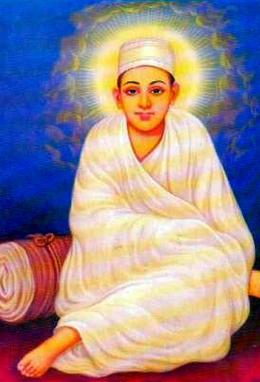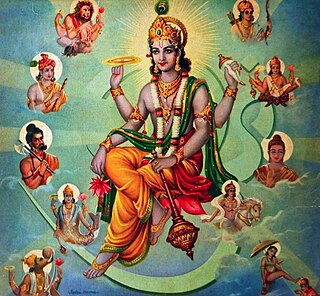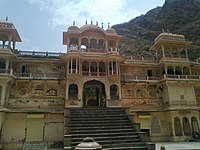
Dattatreya, Dattā or Dattaguru, is a paradigmatic Sannyasi (monk) and one of the lords of yoga, venerated as a Hindu god. He is considered to be an avatar and combined form of the three Hindu gods Brahma, Vishnu, and Shiva, who are also collectively known as the Trimurti, and as the manifestation of Parabrahma, the supreme being, in texts such as the Bhagavata Purana, the Markandeya Purana, and the Brahmanda Purana, though stories about his birth and origin vary from text to text. Several Upanishads are dedicated to him, as are texts of the Vedanta-Yoga tradition in Hinduism. One of the most important texts of Hinduism, namely Avadhuta Gita is attributed to Dattatreya. Over time, Dattatreya has inspired many monastic movements in Shaivism, Vaishnavism, and Shaktism, particularly in the Deccan region of India, Maharashtra, Gujarat, Madhya Pradesh, Rajasthan and Himalayan regions where Shaivism is prevalent. His pursuit of simple life, kindness to all, sharing of his knowledge and the meaning of life during his travels is reverentially mentioned in the poems by Tukaram, a saint-poet of the Bhakti movement.

Ramananda or Swami Ramanand was a 14th-century Vaishnava devotional poet saint, who lived in the Gangetic basin of northern India. The Hindu tradition recognizes him as the founder of the Ramanandi Sampradaya, the largest monastic Hindu renunciant community in modern times.

Nath, also called Natha, are a Shaiva sub-tradition within Hinduism in India and Nepal. A medieval movement, it combined ideas from Buddhism, Shaivism and Yoga traditions of the Indian subcontinent. The Naths have been a confederation of devotees who consider Shiva as their first lord or guru, with varying lists of additional gurus. Of these, the 9th or 10th century Matsyendranatha and the ideas and organization mainly developed by Gorakhnath are particularly important. Gorakhnath is considered the originator of the Nath Panth.

Baladeva Vidyabhushana was an Indian Gaudiya Vaishnava acharya. Despite being renowned all over the world as the Gaudiya Vedanta Acarya, the scarcity of available authentic bio data has led misinformed authors to spread incorrect information about his life incidents. Early tradition and manuscripts point out that he was born in Utkala, or the present day Odisha. Yet there is no known historical evidence regarding either his exact birthplace or date, nor any reference to it in his works. Some believe that he was born in a village near Remuna, Balasore, where the famous temple of Khirachora Gopinatha is located. However, it is not clear what the source of this claim is, since those who defend this view have not presented any evidence to justify it.
Govinda Bhashya is a Gaudiya Vaishnava commentary (bhasya) on the Vedanta Sutra. It was written in the year 1628 Sakabda at Galtaji (Galta) near the present city of Jaipur, Rajasthan, by Baladeva Vidyabhushana to defend Gaudiya Vaishnava theology.
Sampradaya, in Indian origin religions, namely Hinduism, Buddhism, Jainism, and Sikhism, can be translated as 'tradition', 'spiritual lineage', 'sect', or 'religious system'. To ensure continuity and transmission of dharma, various sampradayas have the Guru-shishya parampara in which parampara or lineage of successive gurus (masters) and shishyas (disciples) serves as a spiritual channel and provides a reliable network of relationships that lends stability to a religious identity. Shramana is vedic term for seeker or shishya. Identification with and followership of sampradayas is not static, as sampradayas allows flexibility where one can leave one sampradaya and enter another or practice religious syncretism by simultaneously following more than one sampradaya. Samparda is a punjabi language term, used in Sikhism, for sampradayas.
Jagadguru, literally meaning "guru of the universe", is a title used in Sanātana Dharma. Traditionally, it has been bestowed upon or used for ācāryas belonging to the Vedānta school who have written Sanskrit commentaries on the Prasthānatrayī – the Brahma sūtras, the Bhagavad-gītā and the principal Upaniṣads. Historically, jagadgurus have established a lineage and an institution to spread dharma which has been based in Varanasi, the centre of Sanskrit study.

A matha, also written as math, muth, mutth, mutt, or mut, is a Sanskrit word that means 'institute or college', and it also refers to a monastery in Hinduism. An alternative term for such a monastery is adheenam. The earliest epigraphical evidence for mathas related to Hindu-temples comes from the 7th to 10th century CE.

Sant Dadu Dayal was a poet-saint from Gujarat, India, a religious reformer who spoke against formalism and priestcraft.

The Ramanandi, also known as Ramavats, is one of the largest sect of Vaishnavas. Out of 52 gates of Vaishnavism divided into 4 Vaishnava Sampradayas, 36 are held by Ramanandi. The sect mainly emphasizes the worship of Rama, Sita, and Hanuman and avatars of Vishnu. They consider Rama and Sita as Supreme Absolute who are non different from each other. It is considered to have been founded by Ramananda, a 14th-century Vaishnava saint.

Gorakhnath was a Hindu yogi, saint who was the founder of the Nath Hindu monastic movement in India. He is considered one of the two disciples of Matsyendranath. His followers are known as Jogi, Gorakhnathi, Darshani or Kanphata.

Vaishnavism is one of the major Hindu denominations along with Shaivism, Shaktism, and Smartism. It is also called Vishnuism since it considers Vishnu as the sole supreme being leading all other Hindu deities, that is, Mahavishnu. Its followers are called Vaishnavites or Vaishnavas, and it includes sub-sects like Krishnaism and Ramaism, which consider Krishna and Rama as the supreme beings respectively. According to a 2010 estimate by Johnson and Grim, Vaishnavism is the largest Hindu sect, constituting about 641 million or 67.6% of Hindus.

Galtaji is an ancient Hindu pilgrimage about 10 km away from Jaipur, in the Indian state of Rajasthan. The site consists of a series of temples built into a narrow crevice in the ring of hills that surrounds Jaipur. A natural spring emerges high on the hill and flows downward, filling a series of sacred kunds in which pilgrims bathe. Visitors and pilgrims can ascend the crevasse, continuing past the highest water pool to a hilltop temple from there are views of Jaipur and its fortifications spreads out across the valley floor. It is believed that a Saint named Galav lived here, practiced meditation, and did penance (tapasya).

Akhara or Akhada is an Indian word for a place of practice with facilities for boarding, lodging and training, both in the context of Indian martial artists or a sampradaya monastery for religious renunciates in Guru–shishya tradition. For example, in the context of the Dashanami Sampradaya sect, the word denotes both martial arts and religious monastic aspects of the trident wielding martial regiment of the renunciating sadhus.

The Nimbarka Sampradaya, also known as the Kumāra Sampradāya, Hamsa Sampradāya, and Sanakādi Sampradāya, is one of the four Vaiṣṇava Sampradāyas. It was founded by Nimbarka, a Telugu Brahmin yogi and philosopher. It propounds the Vaishnava Bhedabheda theology of Dvaitadvaita (dvaita-advaita) or dualistic non-dualism. Dvaitadvaita states that humans are both different and non-different from Isvara, God or Supreme Being. Specifically, this Sampradaya is a part of Krishnaism—Krishna-centric traditions.
Hindu denominations, sampradayas, traditions, movements, and sects are traditions and sub-traditions within Hinduism centered on one or more gods or goddesses, such as Vishnu, Shiva, Shakti and so on. The term sampradaya is used for branches with a particular founder-guru with a particular philosophy.

The Advaita Guru-Paramparā is the traditional lineage (parampara) of divine, Vedic and historical teachers of Advaita Vedanta. It begins with the Daiva-paramparā, the gods; followed by the Ṛṣi-paramparā, the Vedic seers; and then the Mānava-paramparā, with the historical teachers Gaudapada and Adi Shankara, and four of Shankara's pupils. Of the five contemporary acharyas, the heads of the five Advaita mathas, four acharyas trace their lineage to those four pupils and one to Adi Shankara himself.

Krishnadas Payahari, also known as Payahari Baba was a Ramanandi Hindu saint and disciple of Anantananda, one of the twelve disciple of Ramananda. Krishnadas Payohari was the founder and first Mahant of Gaddi of Galtaji dham, Jaipur. He came to Galta early in the 16th century. He was the guru of Prithvi Singh, ruler of Amber (Jaipur) and his wife Apurva Devi. He was also guru of Raja Jagat Singh of Kullu.

Bairagi Brahmin or Vaishnav Bairagi or Vaishnav Brahmin is a Hindu caste. They are priests of vaishnava temples. They are sedentary rasik Brahmin members of the Vaishnava sampradayas, especially the Ramanandi Sampradaya. Surnames include Swami, Bairagi, Mahanta, Vaishnav, and Vairagi. They are Vaishnav, and wear the sacred thread. A majority of Bairagi Brahmin is found in Uttar Pradesh, Bihar, Jharkhand, West Bengal, Assam, and Odisha. Bairagi are considered as part of the 'upper castes' of Bengal.Bairagi, Whose Origin happened in the Mughal period to compete with the Muslim invaders. In order to protect the Sanatan Dharma, the Jats, Rajputs, Brahmins etc. who got Vaishnavite initiation from the saints and became their disciples, came to be known as Bairagi. Mainly the founder of Bairagi sect was Swami Ramanandacharya. The descendants of Jats who themselves became Sadhus came to be known as Bairagi, meaning those who have renounced worldly affairs.

Thakurdwara Bhagwan Narainji is a historical Hindu temple belonging to Ramanandi Sampradaya, located in the village Pandori Mahantan in Gurdaspur district of Punjab in India. It constitutes one of the fifty-two Vaishnav dvaras of Indian subcontinent into which Bairagis have been organized. The shrine was founded by Ramanandi saint Shri Bhagwanji and his disciple ShriNarainji after whom the shrine has been name.The temple is known for its spectacular Baisakhi fair.














